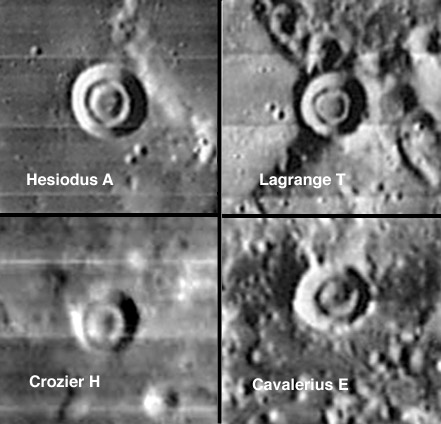June 24, 2015
Concentric Craters
Originally published June 23, 2004
Image Credit: Chuck Wood |
|
Concentric Craters The nearside of the Moon contains more than 11,000 craters larger than 3.5 km wide. Virtually all of them are standard impact craters, mostly small, ranging from very fresh to quite degraded. There are a handful of oddball craters and one of the weirdest and least studied are concentric craters. These are small craters - on average 8 km in diameter, that contain an inner ring approximately half the crater width. The most famous concentric crater is Hesiodus A on the south shore of Mare Nubium. According to a paper I published in 1978 (see link) Hesiodus A is 14.9 km wide, 1.7 km deep impact crater, surrounded by a faint ejecta blanket. Inside Hesiodus A is a 6 km wide donut-like ring. back in 1978 I cataloged 51 concentric craters and 70% looked similar to Hesiodus A. It is strongly unlikely that these bulls-eye crater within crater structures formed by two unrelated chance impacts. A number of the craters are located near domes and rilles, and 70% occur on the margins of maria. These spatial relations suggested to me that the inner rings were volcanic in origin. Perhaps an effusive flow of relatively viscous magma from fractures at the edge of the crater's floors built up the inner rings. Today, this interpretation is not very compelling to me as it was 26 years ago. But, suggestions that the rings are some sort of wall slump features within normal impact craters is also unbuttressed by any significant evidence. I don't know how to interpret concentric craters - do you? Related Links: Yesterday's LPOD: A Fundamental Relation Tomorrow's LPOD: Gambart Environs |
Author & Editor: |
COMMENTS?
Register, Log in, and join in the comments.




